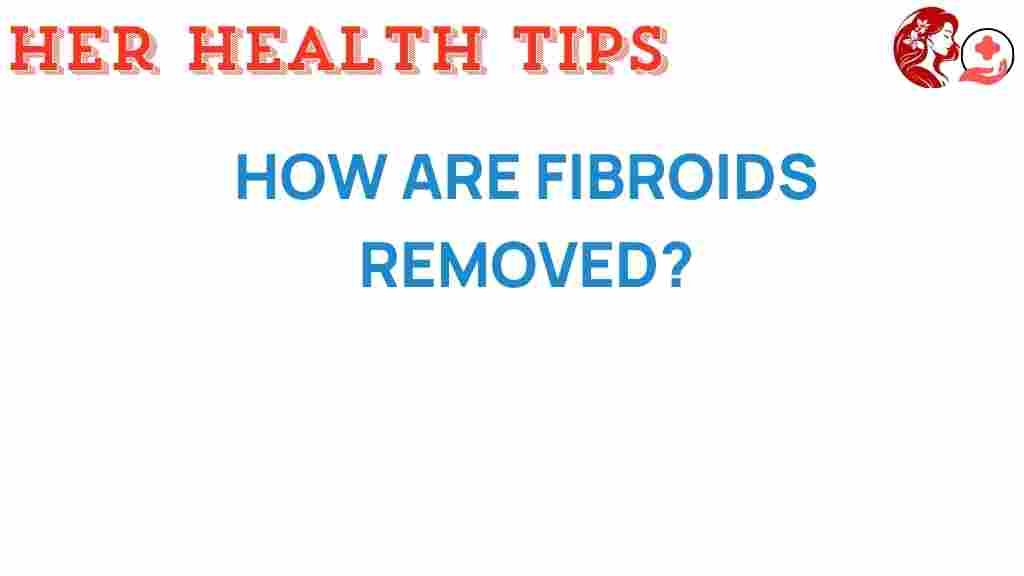Unveiling the Secrets: How Are Fibroids Removed?
Fibroids are noncancerous growths that develop in or on a woman’s uterus, affecting a significant number of women during their reproductive years. According to estimates, around 70-80% of women will develop fibroids by the age of 50. While many women experience no symptoms, some may face complications that require intervention. This article delves into the various removal methods available for fibroids, the associated health implications, and what women need to know about these treatment options.
Understanding Fibroids
Before exploring the removal methods, it’s crucial to understand what fibroids are. These growths can vary in size, location, and number. They can be classified into three main types:
- Intramural Fibroids: These grow within the uterine wall and are the most common type.
- Subserosal Fibroids: These extend outside the uterus and can sometimes cause pressure on surrounding organs.
- Submucosal Fibroids: These grow just beneath the lining of the uterus and can affect menstrual bleeding.
Women’s wellness can be impacted by fibroids in various ways, leading to symptoms such as heavy menstrual bleeding, pelvic pain, and complications during pregnancy. Understanding these effects is essential for determining whether treatment is necessary.
Myths Surrounding Fibroids
Several myths surround fibroids that can mislead women about their health:
- Myth 1: Fibroids always require surgery.
Reality: Many women with fibroids experience no symptoms and may not need treatment. - Myth 2: Fibroids can turn into cancer.
Reality: Fibroids are benign and do not increase cancer risk. - Myth 3: All fibroids cause symptoms.
Reality: Many women with fibroids have no noticeable symptoms.
Fibroids: Removal Methods Explained
When removal methods are necessary, there are several options available, ranging from non-invasive treatments to surgical procedures. Below are the most common methods utilized for removing fibroids:
1. Medications
Before considering surgical options, doctors may recommend medication to help manage symptoms associated with fibroids:
- Hormonal therapies: Birth control pills or hormone therapy can help regulate menstrual cycles and reduce heavy bleeding.
- Gonadotropin-releasing hormone (GnRH) agonists: These medications can shrink fibroids temporarily by inducing a menopause-like state.
- Nonsteroidal anti-inflammatory drugs (NSAIDs): These can help relieve pelvic pain and discomfort.
2. Non-Surgical Options
For women who prefer to avoid surgery, several non-surgical options are available:
- Uterine Fibroid Embolization (UFE): This minimally invasive procedure involves blocking the blood supply to the fibroids, causing them to shrink.
- Ultrasound-Guided Focused Ultrasound Surgery (FUS): This technique uses high-frequency sound waves to destroy fibroid tissue non-invasively.
- Myolysis: This procedure uses laser energy, electrosurgery, or cryotherapy to destroy fibroid tissue.
3. Surgical Options
When fibroids cause severe symptoms or complications, surgical intervention may be necessary. The following surgical options are commonly performed:
- Myomectomy: This surgery involves the removal of fibroids while preserving the uterus. It can be performed through various approaches, including:
- Abdominal Myomectomy: A larger incision is made in the abdomen.
- Laparoscopic Myomectomy: This minimally invasive technique uses small incisions and a camera.
- Hysteroscopic Myomectomy: This procedure is performed through the vagina and cervix, removing submucosal fibroids.
- Hysterectomy: This is the complete removal of the uterus and is often recommended for women who have severe symptoms or do not wish to preserve fertility.
Recovery After Fibroid Removal
Recovery time after fibroid removal varies depending on the method used:
- Medications: Recovery from medication is immediate, but symptom relief may take time.
- Minimally Invasive Procedures: Recovery can take only a few days, and most women return to normal activities within a week.
- Surgical Procedures: Recovery from myomectomy or hysterectomy may take several weeks, with full recovery taking up to six to eight weeks.
During recovery, women should follow their healthcare provider’s recommendations, which may include:
- Avoiding heavy lifting and strenuous activities
- Taking prescribed medications
- Attending follow-up appointments
Tips for a Smooth Recovery
To ensure a smooth recovery, consider the following tips:
- Stay hydrated and eat a balanced diet rich in vitamins and minerals.
- Engage in light walking to promote circulation, as advised by your doctor.
- Listen to your body and rest as needed.
- Seek support from family and friends during the recovery process.
Consulting Healthcare Providers
It’s essential for women experiencing symptoms related to fibroids to consult with healthcare providers. A thorough evaluation, including imaging tests and physical exams, can help determine the best course of action. Women should feel empowered to ask questions about:
- The nature of their fibroids
- Recommended treatment options
- Risks and benefits of each method
- Expected recovery outcomes
For more information on fibroids, removal methods, and women’s health, you can visit the Office on Women’s Health.
Conclusion
Understanding how fibroids are removed is crucial for women’s wellness. With various removal methods available, including medications, non-surgical options, and surgical interventions, women can find the right treatment for their needs. Myths surrounding fibroids can often lead to confusion, making it essential to engage with healthcare providers who can offer accurate information and guidance.
As women navigate their health journey, being informed about treatment options, recovery processes, and the importance of professional healthcare can empower them to make the best choices for their health. If you suspect you have fibroids or are experiencing symptoms, do not hesitate to reach out to a healthcare professional for an evaluation and to discuss the best options for your situation.
For further reading and support, feel free to explore more resources on this topic here.
This article is in the category Reproductive and created by HerHealthTips Team

1 thought on “Unveiling the Secrets: How Are Fibroids Removed?”